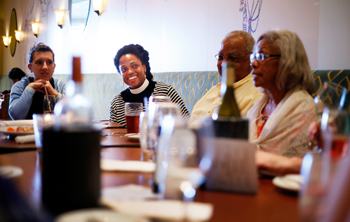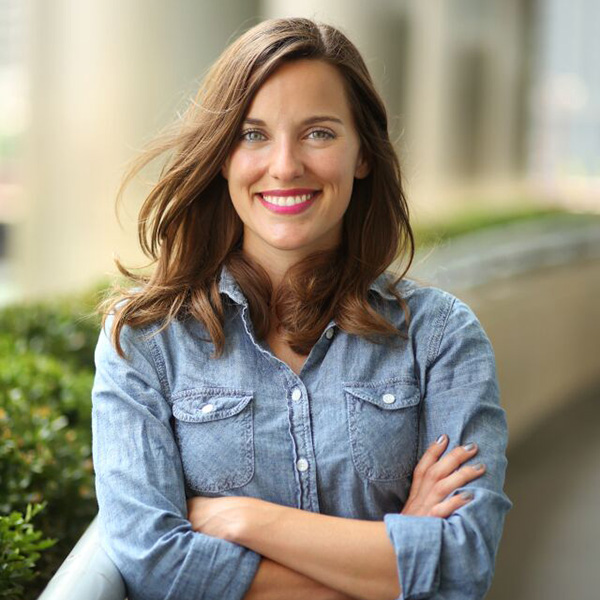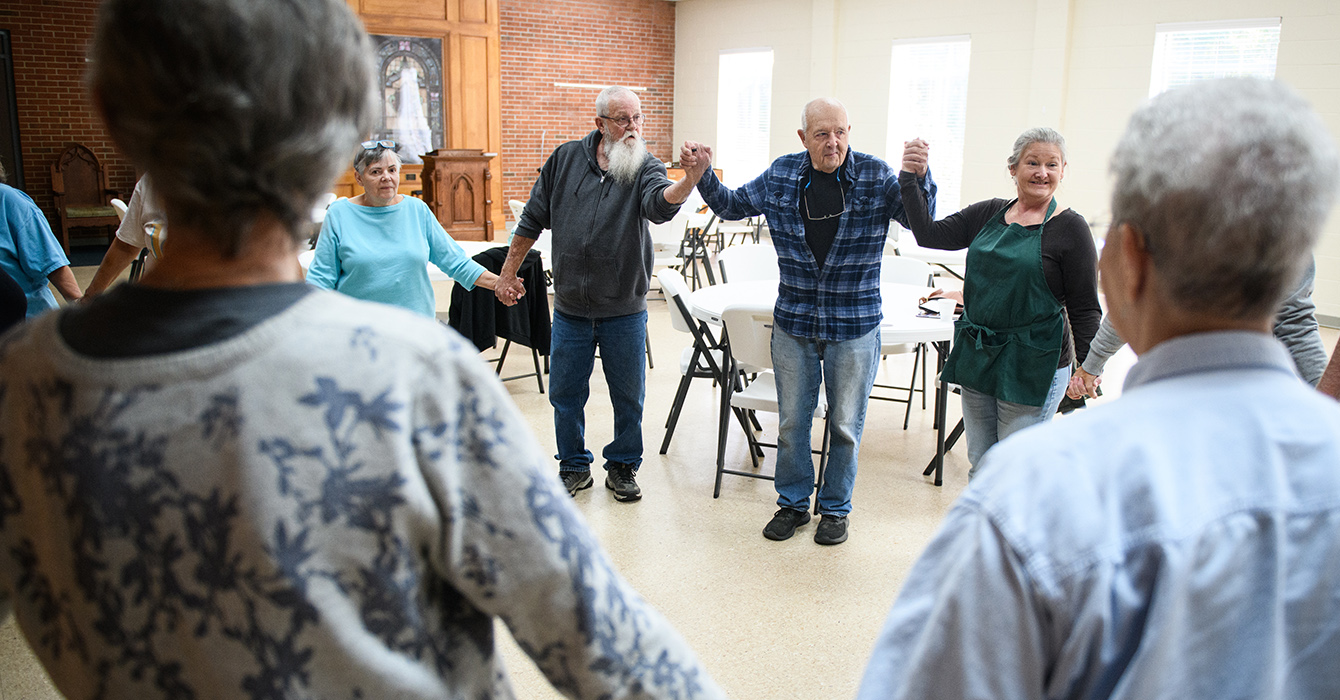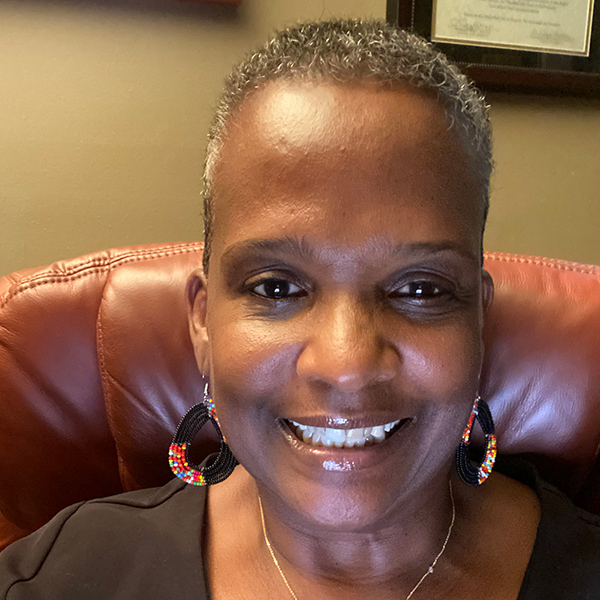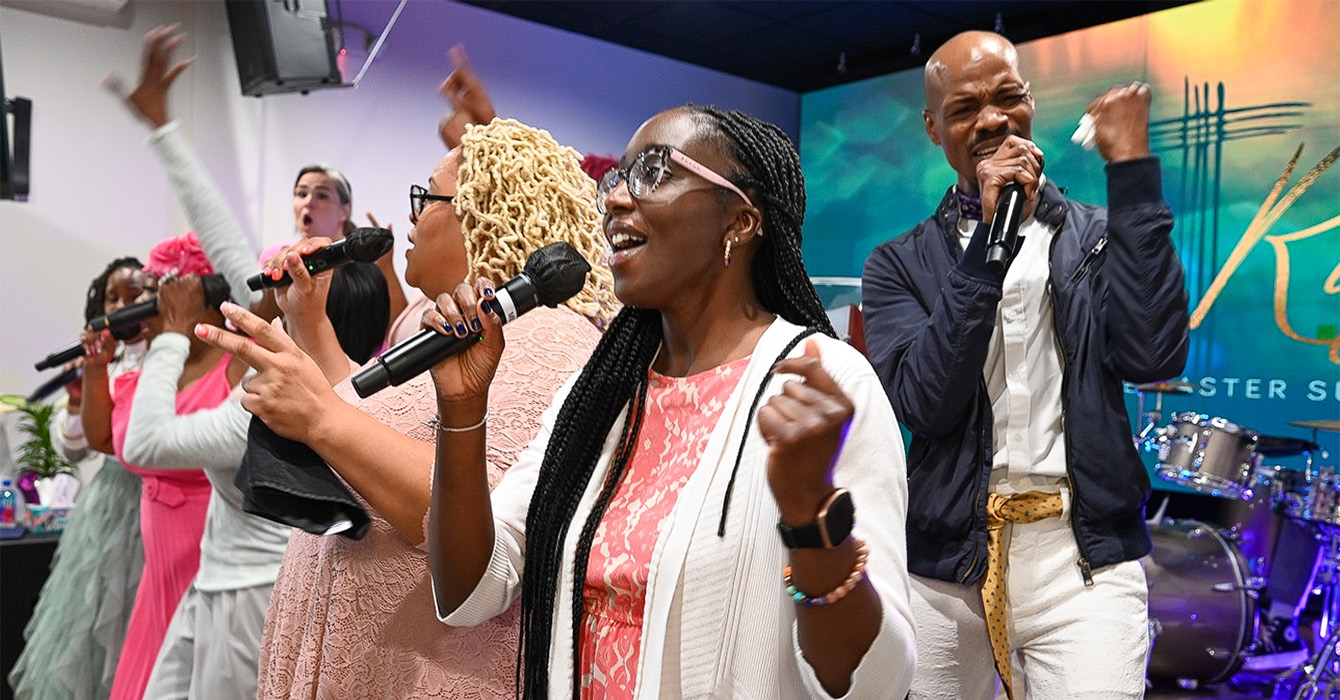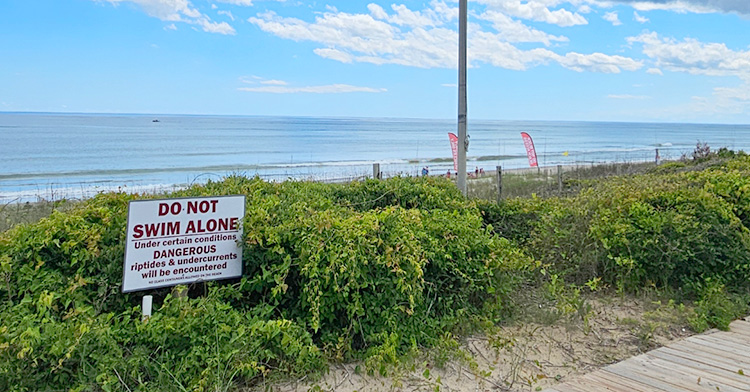Victoria Campbell, the head of Richmond’s community gardening effort, flits from planter to planter, pinching weeds from among the squash, beans, Swiss chard and sweet potatoes sprouting in the giant tubs that ring this downtown parking lot in Virginia’s capital.
All the while, she’s talking a blue streak about the city’s efforts to transform vacant green space, promote care for the environment and teach children in urban housing developments the value of growing their own food.
Matching her step for step and furiously scribbling notes is the Rev. Melanie Mullen, the downtown missioner at St. Paul’s Episcopal Church, 10 blocks away.
Campbell pauses to inspect a small stand of corn, and Mullen seizes the moment.
“Tell me what physically you need, and in what time frame,” Mullen says, following quickly with the question that she’s asked countless organizations in Richmond since starting work for St. Paul’s last fall:
“What do you need that we could provide?”
“How about a few volunteers to weed and water the gardens once or twice a week?” Campbell asks. “And it’d be great,” she adds, “if someone could plant some flowers around the vegetables, something like marigolds or zinnias that might attract beneficial insects.”
“No problem,” says Mullen, who offers to coordinate a weed-and-water meet-up in the parking lot, followed by happy hour at one of the nearby restaurants.
St. Paul’s, a fixture in downtown Richmond for nearly 170 years, has a rich history of reaching out to community members of all faiths and welcoming them in. The church serves a hot lunch to 300 homeless residents every Thursday, partners with an elementary school in a tutoring program that has grown into a citywide interfaith effort, and holds a popular lunchtime speaker series every weekday during Lent that draws thousands.
Questions to consider
Questions to consider:
- In what ways does your organization ask, “What do you need that we could provide?”
- The downtown missioner was created to push old members out into the world, not to bring new members in. Could your institution find new answers by turning familiar challenges “inside out”?
- What does “the art of neighboring” look like in your context? In what specific ways can your institution become a better neighbor?
- Does your organization understand the concerns of its communities? Do you have systems in place to foster understanding?
But Mullen’s mission differs from traditional outreach endeavors. Though her job certainly includes inviting outsiders into St. Paul’s, her main focus is on nudging its 900 members out -- beyond the Tiffany stained-glass windows, the Corinthian columns and the pews where Confederate leaders worshipped -- and into the surrounding neighborhoods.
There, it is hoped, they’ll practice what Mullen calls “the art of neighboring,” engaging with residents, supporting local businesses, aiding efforts to improve life in the city and otherwise spreading the church’s ethos in a way that benefits the broader downtown area.
“This isn’t about increasing membership. It’s not about raising funds or getting a better bottom line,” said vestry member Brian Levey, a member of the search committee that hired Mullen.
“It’s truly about how does St. Paul’s become a better neighbor and help build a better community in downtown. We wanted somebody to help build a vision, to help us get outside the walls of St. Paul’s.”
A familiar face
To that end, Mullen, a gregarious 38-year-old, has become a familiar face at neighborhood gatherings, engaging with people who feel spiritually connected to the city -- if not a church -- and helping them match community needs with church-based resources.
While Mullen holds the title of downtown missioner, the mission itself is a collaborative one, she said, relying on the efforts of civic-minded people both within and outside the St. Paul’s congregation. The ultimate goal, she said, is to inspire Richmonders, even those unaffiliated with the church, to put community first.
“The point is not for a couple of groups of us to be good at downtown missioning,” Mullen said. “It’s for all of us to.”
The idea for a downtown missioner didn’t come about overnight, said the Rev. Wallace Adams-Riley, the church’s rector since 2008. Instead, it evolved over several years of conversations within St. Paul’s about what the church’s leadership role in a changing city should be.
Such conversations aren’t new to St. Paul’s, which, like many Southern institutions, has a complicated history. On the one hand, its imposing structure, built in 1845 just a stone’s throw from the Capitol, rose with the help of slave labor. Confederate President Jefferson Davis and Gen. Robert E. Lee both worshipped at St. Paul’s during the Civil War, and plenty of its parishioners fought for the South.
But decades later, many of the church’s members and clergy would fight for civil rights. And when Virginia’s L. Douglas Wilder became the nation’s first elected African-American governor, his pre-inaugural prayer service was held at St. Paul’s.
Still, the church stood firm on some traditions, including its location. In the late 1950s, as many churches followed their congregations into the suburbs, St. Paul’s made the decision to stay downtown.
“That remains very important to this church’s self-understanding, that commitment and presence downtown,” Adams-Riley said. “Being downtown is really core for us.”
When Adams-Riley arrived, parishioners were trying to discern what that commitment should look like in the 21st century. The blocks around St. Paul’s had long teemed with city, state and federal workers between the hours of 9 and 5 on weekdays, and the church had a tradition of welcoming them for both religious and social events.
But for the first time in decades, people were moving back into the city’s center to live. Long-abandoned factories were being converted into condos for young professionals. Areas that had once been no-go zones after dark were experiencing a renaissance, with new restaurants, shops and farmers’ markets. How could the church contribute to that rebirth?
One of his first conversations was with the Rev. Ben Campbell, a priest-in-residence at St. Paul’s and the founder of Richmond Hill, a nearby ecumenical religious community devoted to healing the city. Campbell urged the church to create a position for a priest who would focus on marshaling the forces of St. Paul’s in behalf of downtown, Adams-Riley said.
A line being cast from the church
“He said he had this vision, an image welling up like a line being cast from the church into the community,” Adams-Riley said. “He had this idea of calling someone totally dedicated to reaching out in fresh ways, to knocking on doors that we haven’t already knocked on, to approaching people not thinking about church at all or who had stopped thinking about church, to help them experience church in a new way, to help them understand what church, what the gospel, what Jesus means to them.”
After two and a half years of parish-wide discussions, a consensus emerged, focused more on the philosophy behind the downtown missioner position -- the church would be a sort of base camp for promoting and organizing good works -- than on the specific duties of the job.
In fact, each applicant was asked to share his or her own vision for what the downtown missioner should be. To Mullen, then a student at Virginia Theological Seminary, the job was more akin to street ministry than traditional parish work. Having grown up in Charlotte, N.C., she pointed to her upbringing as a black Presbyterian in the South -- “which is kind of like being a Martian” -- as proof that she’d have no problem operating outside the box.
Before attending seminary, Mullen had studied women’s history at the University of North Carolina, where, by the time she graduated, she had clocked more hours volunteering than in class. She earned a master’s degree in black women’s history from Clark Atlanta University before moving to Washington, D.C., to work as a fundraiser for various political campaigns and, later, for nonprofits.
There, she lived in an apartment in Dupont Circle above St. Margaret’s Episcopal Church, a congregation with a long history of promoting faith in action. Soon, she joined and became an Episcopalian.
“Being in an urban church that functions well really shaped me,” Mullen said.
Drawing on that experience, Mullen wasted no time meeting with other Richmond churches and civic organizations -- and even local businesses, at chamber of commerce mixers -- after starting work at St. Paul’s.
“My job is not totally liturgical,” Mullen said. “Richmond is full of altruistic, idealistic people. How can the church partner with them to improve the city and support existing programs?”
Mullen and her leadership committee -- six parishioners and a nonmember who works downtown -- had no trouble coming up with ways to engage the surrounding community. Executing those plans, however, was a little more difficult, Mullen said.
Embracing the ‘e-word’: evangelism
Members had to reconsider and think through the nature of evangelism, something that Episcopalians are not known for. Even now, the group wrestles with what it feels like to embrace the “e-word” -- evangelism -- and what spreading the good news looks like, Mullen said.
“We’re making it up as we go along,” Mullen said. “As much as we said we wanted to be out there talking to people, it was uncomfortable.”
Levey, who grew up in a Pentecostal Assemblies of God congregation, said the downtown missioner program is not about proselytizing. It’s about listening to the community’s concerns and finding concrete ways the church can address them.
“How do you build a community informed by faith, but not necessarily do it in a church setting?” he said. “If we can learn how to be part of those conversations in a listening way and bring our resources to the table to solve those problems, that’s in part fulfilling what we’d like to see happen.”
The downtown missioner is not a soup kitchen or a campus ministry or an outreach effort targeted at people who are poor or homeless, Levey said.
“It’s much wider. This is a really different kind of outreach, one more grounded in relationships, grounded in community.”
So far, the program has acted in two broad categories: social and religious.
Mullen, who lives in a converted ice plant a mile away from the church, holds Friday morning office hours at a downtown bakery, where she chats with other residents over pastries. She uses Twitter (@missionrva), Pinterest and Meetup.com to invite Richmonders to participate in activities that provide fellowship and benefit the city -- events such as unity walks, community garden plantings, restaurant tours and even First Friday celebrations at St. Paul’s, featuring a band, food trucks, and art exhibits in the parish hall.
Under Mullen’s direction, St. Paul’s has also pursued “public liturgy.” On Good Friday, she organized a Stations of the Cross exhibit and service at a nearby farmers’ market, providing an opportunity to engage people who might never have wandered up the steps of St. Paul’s.
On Ash Wednesday, Mullen and members of St. Paul’s took containers of ashes that had been blessed at the altar and carried them around downtown, offering imposition of the ashes to anyone who wanted it. The response -- from nearby medical students, office workers and parking garage attendants -- was overwhelmingly positive, Mullen said.
When one St. Paul’s member complained that “Ashes to Go” seemed too casual, member Maureen Hains gently reminded him that Jesus didn’t operate from within a church, Hains said.
Not about the building
“If the church is going to be successful in the future, we need to look back and look at what Jesus did. Jesus taught and walked around,” Hains said. “It’s not about the building. It’s about the people.”
Many of those people, Hains added, drive past other Episcopal churches on Sunday mornings just to attend St. Paul’s.
“If you’re going to St. Paul’s and not interacting with the people of downtown, then why are you there?” she said. “My hope would be that people don’t steer away from things that are new because they’re unsure. My hope is that St. Paul’s embraces the newness and just really listens to the Spirit calling them.”
Occasionally, members ask Adams-Riley whether Mullen’s work will translate into more people in the pews. The downtown mission is less about bumping up the roster, he said, than it is about being a catalyst for community change. And even though some of Mullen’s efforts are experimental, this type of outreach isn’t all that radical, he said.
“Don’t we know -- from the beginning, to use a biblical phrase -- that Jesus called us to go out into the world?” Adams-Riley said. “That call has always been there. In this environment, let’s make sure we are being courageous and imaginative and trying to really listen deeply to what God would have us do.
“How would we re-imagine the church? What would a fresh expression of St. Paul’s be now? We try to breathe deeply and trust that God is actually here and is involved in this and inspired this. We believe that and trust that.”
For now, it’s difficult to measure the program’s success. Mullen’s been on the job only nine months, and, unlike a membership drive or a capital campaign, the mission pursues goals that aren’t easily quantified.
For Levey, the downtown mission is working if it accomplishes two objectives: expanding the church’s programming beyond anything it’s done before and challenging members to engage with others in new and beneficial ways.
“We’re pretty much breaking new ground in Virginia,” he said. “I think it’s a pretty bold step. To say that we’re unclear where exactly this is going, but we’re committed to doing it and following through, takes a measure of faith.”


